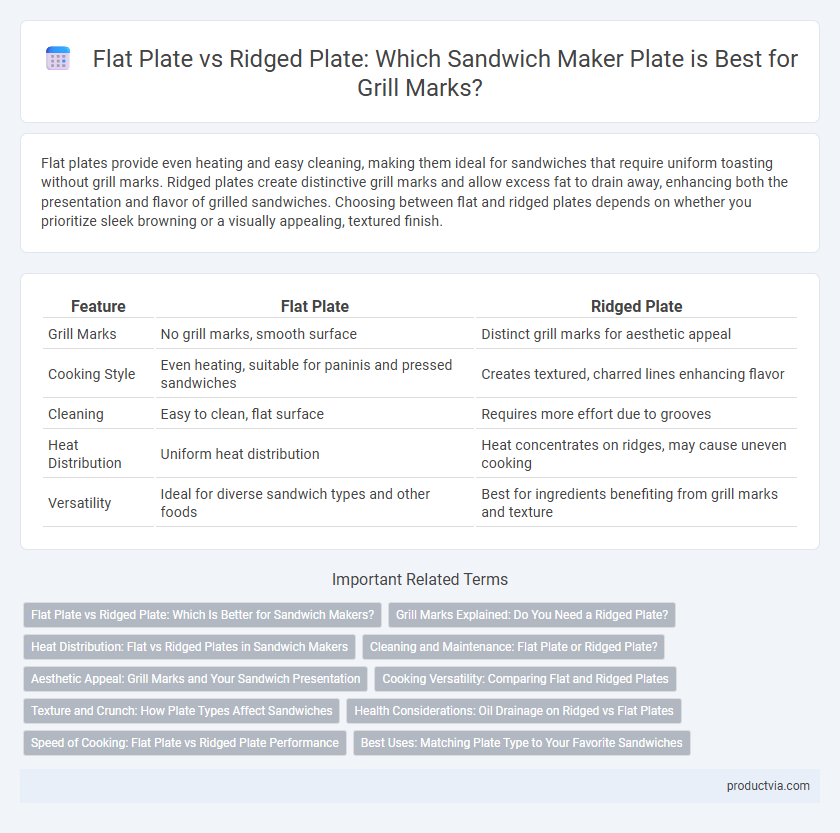Flat plates provide even heating and easy cleaning, making them ideal for sandwiches that require uniform toasting without grill marks. Ridged plates create distinctive grill marks and allow excess fat to drain away, enhancing both the presentation and flavor of grilled sandwiches. Choosing between flat and ridged plates depends on whether you prioritize sleek browning or a visually appealing, textured finish.
Table of Comparison
| Feature | Flat Plate | Ridged Plate |
|---|---|---|
| Grill Marks | No grill marks, smooth surface | Distinct grill marks for aesthetic appeal |
| Cooking Style | Even heating, suitable for paninis and pressed sandwiches | Creates textured, charred lines enhancing flavor |
| Cleaning | Easy to clean, flat surface | Requires more effort due to grooves |
| Heat Distribution | Uniform heat distribution | Heat concentrates on ridges, may cause uneven cooking |
| Versatility | Ideal for diverse sandwich types and other foods | Best for ingredients benefiting from grill marks and texture |
Flat Plate vs Ridged Plate: Which Is Better for Sandwich Makers?
Flat plates provide even heat distribution for uniform toasting and easy cleaning, making them ideal for classic grilled cheese sandwiches. Ridged plates create distinct grill marks and allow fat to drain away, enhancing texture and flavor in paninis or sandwiches with fatty fillings. Choosing between flat and ridged plates depends on whether you prioritize aesthetic grill marks or simplicity and versatility in your sandwich maker.
Grill Marks Explained: Do You Need a Ridged Plate?
Ridged plates on a sandwich maker create distinct grill marks by pressing ridges into the bread, enhancing the visual appeal and texture of the sandwich. Flat plates cook evenly without grill marks, making them ideal for sandwiches where a smooth surface is preferred. Choosing ridged plates is essential for those seeking traditional grill marks and added crispiness on their sandwiches.
Heat Distribution: Flat vs Ridged Plates in Sandwich Makers
Flat plates in sandwich makers offer uniform heat distribution, ensuring even cooking without hotspots for consistent sandwich texture. Ridged plates create defined grill marks by concentrating heat along raised ridges, slightly reducing direct contact area and causing varied heat intensity. Choosing between flat and ridged plates depends on whether the priority is consistent heat distribution or distinctive grill mark aesthetics.
Cleaning and Maintenance: Flat Plate or Ridged Plate?
Flat plates are generally easier to clean and maintain due to their smooth surface, which prevents food from getting trapped in grooves or ridges. Ridged plates, while enhancing grill marks, require more effort to remove residue from the crevices, often needing specialized brushes or tools. Choosing flat plates can significantly reduce cleaning time and improve overall maintenance efficiency for sandwich makers.
Aesthetic Appeal: Grill Marks and Your Sandwich Presentation
Flat plates produce uniform heat and create evenly cooked sandwiches without grill marks, ideal for a smooth, classic presentation. Ridged plates generate distinct grill marks, enhancing the sandwich's aesthetic appeal by adding texture and a visually appetizing charred pattern. Choosing ridged plates elevates sandwich presentation, making the meal more visually striking and appealing for serving or photography.
Cooking Versatility: Comparing Flat and Ridged Plates
Flat plates provide uniform heat distribution ideal for sandwiches, pancakes, and grilled cheese, enhancing cooking versatility with smooth, even surfaces. Ridged plates create distinct grill marks and allow excess fat to drain away, perfect for grilling meats and vegetables with a seared texture. Choosing between flat and ridged plates depends on the desired cooking style and the variety of foods prepared.
Texture and Crunch: How Plate Types Affect Sandwiches
Flat plates deliver evenly cooked sandwiches with a consistent, smooth texture, ideal for soft, melt-in-your-mouth fillings. Ridged plates create distinct grill marks that enhance the crunch and add a visually appealing, textured exterior. Choosing between flat and ridged plates directly influences the sandwich's crispiness and overall mouthfeel.
Health Considerations: Oil Drainage on Ridged vs Flat Plates
Ridged plates on sandwich makers promote oil drainage by allowing excess fat to collect in the grooves, reducing overall oil contact with food and potentially lowering calorie intake. Flat plates lack this drainage feature, causing food to sit in its own oil, which may increase fat absorption during cooking. Choosing ridged plates can support healthier grilling by minimizing the amount of retained oil in sandwiches.
Speed of Cooking: Flat Plate vs Ridged Plate Performance
Flat plates heat evenly and provide consistent contact with the sandwich surface, resulting in faster cooking times compared to ridged plates. Ridged plates create grill marks but cook slightly slower due to reduced surface contact and uneven heat distribution. For users prioritizing speed and even cooking, flat plates offer superior performance over ridged plates.
Best Uses: Matching Plate Type to Your Favorite Sandwiches
Flat plates provide evenly heated surfaces ideal for grilling delicate sandwiches like grilled cheese and paninis, ensuring consistent browning without pressing out fillings. Ridged plates create distinctive grill marks and channel fats away, making them perfect for hearty sandwiches with thicker ingredients such as steak or vegetable melts. Choosing the right plate type enhances texture and flavor, matching the cooking method to the sandwich's composition and desired presentation.
Flat plate vs ridged plate for grill marks Infographic

 productvia.com
productvia.com